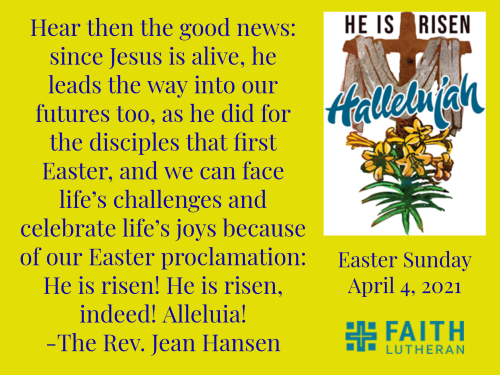
But Wait … more Anxiety … and also Hope
Apr 04, 2021
Sermon 4-4-2021
The Resurrection of Our Lord
Text: Mark 16:1-8
Pastor Jean M. Hansen
Enter Mary Magdalene, Mary the mother of James, and Salome, three women, three disciples of Jesus. One would think that they would be joining us in proclaiming, “He is risen! He is risen indeed! Alleluia!” We celebrate with flowers, music, and butterfly reminders of the possibility of transformation. At least celebrating would be their mood when we reach verse 8, the end of the story, wouldn’t it?
But that’s not the case. Instead, there’s anxiety … anxiety that grows. We can imagine that these women were overwhelmed with grief and fear after witnessing the crucifixion. Perhaps they experienced a moment of relief as Jesus’ body was placed in the tomb; it was over; they knew what to do next – prepare his body for interment. But they could not do this familiar and loving task immediately; it was the Sabbath.
So, a flickering of anxiety hiding behind the relief grew. It expanded throughout the Saturday Sabbath. Is his body safe, they wonder? Will we be safe when we go to tend it? The followers of Jesus are, after all, hiding behind locked doors due to fear of both the Jewish religious leaders and the Romans. As soon as the sun begins to rise on Sunday morning, when few people are out and about, they head for the tomb.
But wait, their anxiety expands: who will move the stone at the tomb’s entrance? If there are guards there, will they help or mock them? But wait, more anxiety: as they arrive, they are shocked to see that the stone has been moved. Who moved it and how? Has Jesus’ tomb been desecrated by vandals? But wait, the anxiety rises: who is this youth? Why is he sitting there so calmly? But wait, anxiety becomes alarm: Where is Jesus’ body?
It is interesting that we tend to think that once the heavenly messenger speaks, telling them not to be alarmed, they stop being anxious and listen wide-eyed as four things are made clear. #1 – They are in the right tomb, since they are looking for Jesus of Nazareth who was crucified. #2 – That he has been raised. That is why #3 – He is not here. If they need convincing, #4 – look, the place where they laid him is empty.
But wait, there is a command: “Go, tell his disciples and Peter (who is particularly suffering after betraying Jesus) that he (Jesus) is going ahead of you to Galilee; there you will see him, just as he told you.” What great news! No doubt they joyfully went to inform their friends of this exciting turn of events.
But wait, that is not the case. Instead, their anxiety goes through the roof: “So they went out and fled the tomb, for terror and amazement had seized them; and they said nothing to anyone, for they were afraid.” How do you like those verbs – fled, seized – this is not garden-variety anxiety. There, Mark’s account ends.
It is true that if you open your Bible, you will see more, what is labeled a shorter and longer ending. There’s nearly universal agreement among scholars that those verses are not original to Mark but were added later by those who were anxious that the Gospel had not ended appropriately.
And, so, the story ends with anxiety, not celebration. Why? I think it is because that was the reality, at least for Mary Magdalene, Mary and Salome, and probably many others. But wait, the women’s anxious silence was not the end of the story, or we would not be here today celebrating. In time, the awesome reality of the resurrection of Jesus overcame the fearful anxiety.
The story is not over at the empty tomb that first Easter. It is just getting started. Jesus’ triumph over sin and death is a continuing story with the power to transform anxiety into celebration.
In the most recent Christian Century magazine, Peter W. Marty tells a story from his own family’s history. It seems that his maternal grandmother, Elsa, died at her kitchen table in 1936; she was only 40 years old. Her husband, a Lutheran pastor, struggled to get beyond his grief, and that ended up impacting the childhood of his daughter, Pastor Marty’s mother who was 8 years old at the time.
Every Sunday afternoon the grief-stricken pastor made his daughter (and that is the word she used) accompany him to Cave Hill Cemetery to visit Elsa’s grave. The weekly ritual cast such a pall over her young life that it essentially blocked every other childhood memory, writes Pastor Marty. Who wonders if the resurrection was the last thing on his grandfather’s mind as he trudged to the cemetery each week. What shape do you suppose his Easter preaching took?
What if, Pastor Marty imagines, a gravedigger would have walked up to his Grandfather one Sunday at Cave Hill and said straight to his face: “You know, you really need to go and do something else with your Sundays. Good years are still ahead of you and your daughter. Go and make something of your life that is not going to happen here. I’ll take care of the grave.” (1)
Accounting for the fact that people do grieve in varied ways, and that is necessary, what Pastor Marty imagines is a very specific – even challenging - a message of hope in the face of death. Isn’t that what happened to Mary Magdalene, Mary, and Salome too?
Pastor Marty suggests that the young man in the white robe played the role of the gravedigger he describes confronting his grandfather and interrupts the women’s grief to say: “I know you’re here for Jesus of Nazareth. But he is not here. You need to go and do something with your grief. There is a good life out there in front of you. Go now and tell some others what I am telling you: Jesus has been raised and is a good bit ahead of you. He’s gone on to Galilee. That’s where you can catch up with him.” (2) Jesus led the way into their future, making it possible for them to set aside their anxiety and proclaim the great good news of their risen Lord.
My friends in Christ, anxiety is a reality, so is fear, so is grief; we all have faced the unknown, the daunting, the loss, and death that trigger those feelings within us. Perhaps that has been more of a reality in the past year than usual. That is certainly the case for the loved ones of the thousands who have died due to Covid-19 and thousands of others who have faced illness and financial loss due to the pandemic.
On Easter last year, we focused on facing the unknown, the risen Lord at our side. Who knew then the trauma that would unfold? Here we are again, still anxious, still facing the unknown, always confronted with loss and death. Hear then the good news: since Jesus is alive, he leads the way into our futures too, as he did for the disciples that first Easter, and we can face life’s challenges and celebrate life’s joys because of our Easter proclamation: He is risen! He is risen, indeed! Alleluia! Amen
(1) “Living by the Word”, April 4, 2021, Mark 16:1-8, by Peter W. Marty, Christian Century, March 24, 2021, pg. 22
(2) Same as #1






